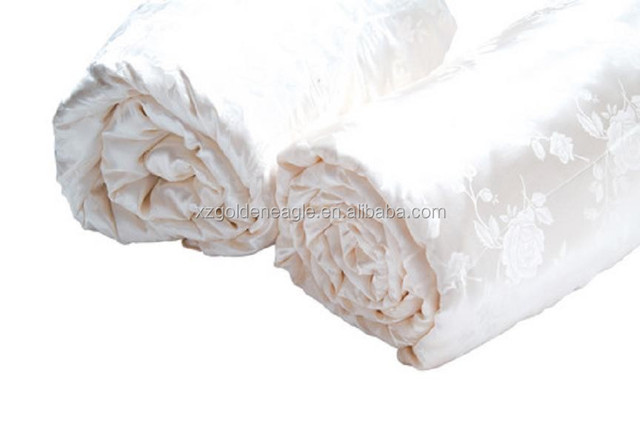Title: Thermal Insulation of Down and Silk Quilts
Title: Thermal Insulation of Down and Silk Quilts,Down and silk quilts are both popular types of bedding used for their warmth and comfort. However, when it comes to thermal insulation, they have different properties. Down is a natural material that traps air, providing exceptional insulation. It is lightweight, breathable, and hypoallergenic, making it an excellent choice for people with allergies. Silk, on the other hand, is a luxurious fabric that also insulates well but is heavier and less breathable than down. It is also more expensive than down.Both down and silk quilts are effective at retaining body heat, reducing chills, and keeping you warm during cold weather. However, if you prefer a lighter and more breathable option, down may be the better choice. If you value luxury and durability over weight and breathability, silk might be the better option. Ultimately, the choice between down and silk quilts depends on your personal preferences and sleeping needs.
Down and silk quilts are two popular types of bedding used for their excellent thermal insulation properties. They provide warmth, comfort, and durability to users throughout the year. This article compares the thermal insulation performance of down and silk quilts, highlighting their unique features, advantages, and disadvantages.
1. Down Quilts

Down pillows and bedding are made from the soft and lightweight feathers of ducks or geese. They have a natural water-repellent property that helps keep them dry and clean. Down quilts are known for their exceptional warmth-to-weight ratio, providing more heat per square inch than synthetic materials like polyester. Here are some factors that contribute to the thermal insulation of down quilts:
a) Fill Power: The fill power of a down quilt is a measure of how much heat it can trap compared to its weight in ounces. A fill power of 600 or higher indicates a high quality down quilt with excellent thermal insulation properties.
b) Fill Weight: The fill weight is the amount of down filling in the quilt, measured in ounces or pounds. A heavier fill weight results in greater thermal retention and longer lifespan. However, lighter options may be more comfortable and easier to manage during warmer weather.
c) Construction: Down quilts can be made using different filling techniques, such as encased, baffle-stitched, or sandwiched. Each method has its advantages and disadvantages, affecting the overall thermal performance and durability of the quilt.
d) Material Options: Down quilts can be made from various materials, including synthetic blends or natural down alternatives like microfiber or recycled fibers. These options offer similar thermal properties but with different levels of sustainability and environmental impact.
Despite their exceptional thermal insulation, down quilts have some drawbacks. They can be more expensive than synthetic or cotton quilts, and their filling can release small amounts of odor and dust over time. Additionally, they may not be suitable for people with allergies or sensitivities to feathers or down particles.
1. Silk Quilts

Silk is a luxurious fabric made from the fibers of the silkworm cocoon. It is renowned for its softness, smoothness, and breathability, making it an ideal choice for bedding. Silk quilts share some similarities with down quilts in terms of thermal insulation, but they have some distinct differences as well:
a) Thermal Properties: Silk fabrics have low thermal conductivity, meaning they absorb less heat compared to other insulating materials like cotton or wool. However, they can still provide adequate warmth in cooler weather due to their high moisture retention capabilities.
b) Comfort: Silk quilts are known for their gentle touch and smooth texture, which makes them comfortable to sleep under. They are also hypoallergenic and breathable, reducing the risk of skin irritation or allergic reactions for individuals with sensitive skin or allergies.
c) Durability: Silk is a delicate material that requires special care to maintain its beauty and longevity. However, well-made silk quilts can last for many years if properly cared for. They may also be more durable than down quilts due to their low compressibility and ability to resist wrinkles and stains.
d) Environmental Impact: Silk is a natural resource that requires significant labor and resources to produce. Therefore, silk products like quilts may have a higher environmental cost compared to synthetic alternatives like polyester or acrylic. However, there are now sustainable silk options available that use recycled or eco-friendly methods of production.
In summary, down and silk quilts both offer exceptional thermal insulation properties, but their unique characteristics make them suitable for different purposes and preferences. Down quilts excel in maintaining warmth while offering lightweight convenience, while silk quilts prioritize comfort, breathability, and environmental sustainability. Ultimately, the choice between these two types of bedding depends on individual needs, priorities, and values.
Articles related to the knowledge points of this article:
Title: Embracing Luxury: The Serene Experience of Shande Home Textiles Premium Down Quilt
Title: The Application of Feather Quilt Clips in the Textile Industry
Feather Duvet May Leak Feathers
Title: The Down Blanket Challenge: A Battle of Warmth and Comfort



